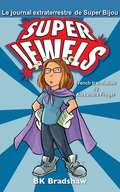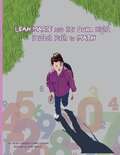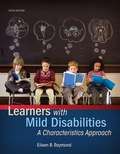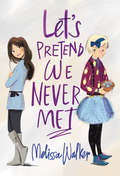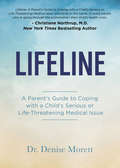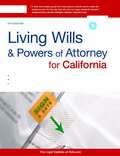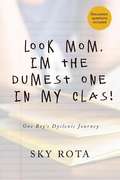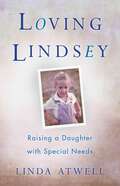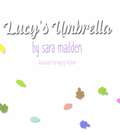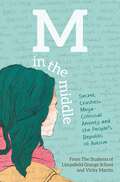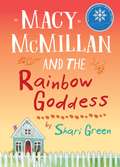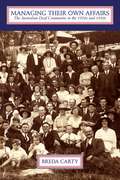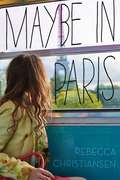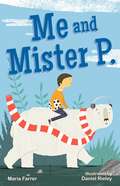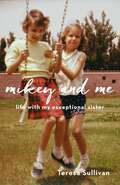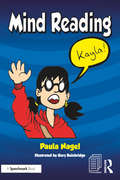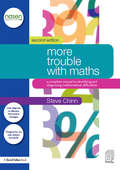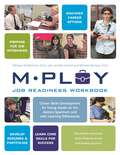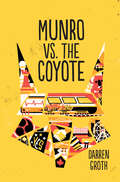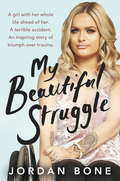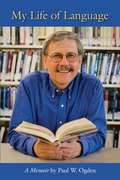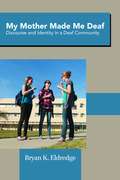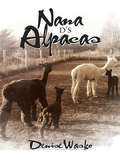- Table View
- List View
Lauren's World: My Life with Cerebral Palsy
by Lauren TrevarthenTake a trip with Lauren as she navigates through her life with Cerebral Palsy. You'll read how just eating a meal can be both satisfying and frustrating at the same time. Lauren hopes you can better understand what it's like living with a physical disability. You can contact me on my website www.queenlaurentrevarthen.com
Le journal extraterrestre de Super Bijou
by Alexandra Froger Bk BradshawPourquoi tout semble si facile pour les autres ? Bijou nous raconte ses aventures de la Maternelle-Prison jusqu'au Collège, tout en cherchant des indices sur ce qui la distingue des autres. Pourrait-elle être une extraterrestre, un super-héro ou quelque chose de complètement différent ? Rejoignez Bijou dans son exploration de ce monde confus - et souvent hilarant - des attentes sociales. Le voyage de Bijou à la découverte de soi, l'emmène à des endroits inattendus et le plus surprenant est de se retrouver un peu nous même en cours de route.
Leah Marie and Her Down Right Perfect Path to Math
by Marylin Leinenbach Anne RaymondThis is a story of a little girl, Leah Marie, who has Down syndrome. As she spends a week with her Gram, she shares with the reader fun ways that she and her Gram recognize and write numbers during the week. Leah Marie also takes the reader on an exciting journey as she shares mathematical shapes that she sees in her world. Leah Marie's message to all the readers is that math can be fun for everyone.
Learners with Mild Disabilities: A Characteristics Approach
by Eileen B. RaymondLearners with Mild Disabilities: A Characteristics Approach focuses on high-prevalence disorders affecting school learners today, including mild intellectual disabilities, learning disabilities, emotional/behavioral disorders, ADHD, autism spectrum disorders, and communication disorders, as well as on low incidence conditions that may manifest in the milder range, for example sensory, physical, health, or TBI. The author lays the foundation for addressing the needs of special learners and then focuses on learners from the perspective of alternative non-categorical frameworks. She describes students with disabilities and related conditions with respect to a variety of individual strengths and needs, considering their cognitive, language, academic learning, and social/emotional characteristics. Readers see how to apply these conceptual frameworks by analyzing a number of vignettes and extended case studies based on the experiences of real children and teachers. Designed as a primary text for use in undergraduate and graduate courses addressing the characteristics of learners with high prevalence or milder levels of disability, the text is also useful for the first specialized course in a special education program. It supports programs in inclusive education or the growing area of generic special education. The Enhanced Pearson eText features embedded video.
Let's Pretend We Never Met
by Melissa Walker“I love how this book gets the fragile ecosystem that is middle school. There’s a purity to the voice that feels very real, very Judy Blume. Loved it!”—R. J. Palacio, author of WonderThe Thing About Jellyfish meets The Kind of Friends We Used to Be in this sweet, honest middle grade debut.If it were up to Mattie Markham, there would be a law that said your family wasn’t allowed to move in the middle of the school year. After all, sixth grade is hard enough without wondering if you’ll be able to make new friends or worrying that the kids in Pennsylvania won’t like your North Carolina accent.But when Mattie meets her next-door neighbor and classmate, she begins to think maybe she was silly to fear being the “new girl.” Agnes is like no one Mattie has ever met—she’s curious, hilarious, smart, and makes up the best games. If winter break is anything to go by, the rest of the school year should be a breeze.Only it isn’t, because when vacation ends and school starts, Mattie realizes something: At school Agnes is known as the weird girl who no one likes. All Mattie wants is to fit in (okay, and maybe be a little popular too), but is that worth ending her friendship with Agnes?
Lifeline: A Parent’s Guide to Coping with a Child’s Serious or Life-Threatening Medical Issue
by Dr. Denise MorettIn Lifeline, Dr. Denise Morett provides validation and support along with tools and strategies on how to cope with a child’s life threatening illness. Denise Morett, Psy. D., is a psychologist with over 25 years of experience treating individuals and families, including those with a family member facing serious or life-threatening medical issues. Dr. Morett found herself in those exact circumstances when her son was diagnosed with a very rare, life-threatening illness. Driven by her own search for supportive re-sources, Dr. Morett provides ways to cope with one of the most challenging circumstances a parent can encounter.
Living Wills and Powers of Attorney for California
by Shae Irving J.D.A serious accident or illness can happen to anyone at any time. That’s why everyone should have these essential documents: An advance health care directive (also called a living will and durable power of attorney for health care), which lets you state your wishes for end-of-life medical care and name a trusted person who will work with your doctors to be sure you get the kind of care you want. A durable power of attorney for finances, which lets you appoint someone you trust to manage your finances for you if you no longer can. The book explains how to create these forms to comply with California law, and how they can be used to help your family. The book also contains instructions for obtaining a Do Not Resuscitate (DNR) order or a Physician Orders for Life-Sustaining Treatment (POLST) form, either of which can be used to let emergency medical responders know that you don’t want certain extreme measures to be used to revive you.
Look Mom, I'm The Dumest One In My Clas!: One Boy's Dyslexic Journey
by Sky RotaLook Mom, I'm the Dumest One in My Clas is the true story of nine-year-old Sky Rota, who during the fourth grade discovers he is severely dyslexic, a disorder Sky and his parents aren't familiar with. Sky and his parents quickly learn dyslexia comes with as many gifts as it does challenges. Hopeful that his school would be understanding and help him embrace and develop his unique methods of learning, they soon realized that they would have to fight for him. Instead of encouraging Sky, his teachers punish him for his "weaknesses. " His school saw his dyslexia as a disability as well, labeling him as different and an outsider. Join Sky as he and his family learn just how reluctant the education system is to accommodate the many different types of learners it's supposed to teach. His bittersweet but ultimately uplifting journey of acceptance will prove that dyslexia is not a hindrance or disability - it's a gift.
Loving Lindsey: Raising a Daughter with Special Needs
by Linda AtwellWinner - 6th Annual Beverly Hills Book Award for Relationships and Parenting & Families Award Finalist in the "Parenting & Family" category of the 2017 Best Book Awards Finalist, 2018 Next Generation Indie Book Awards in the category of Memoirs—Overcoming Adversity/Tragedy Linda Atwell and her strong-willed daughter, Lindsey—a high-functioning young adult with intellectual disabilities—have always had a complicated relationship. But when Lindsey graduates from Silverton High School at nineteen and gets a job at Goodwill, she also moves into a newly remodeled cottage in her parents&’ backyard—and Linda believes that all their difficult times may finally be behind them. Life, however, proves not to be so simple. As Lindsey plunges into adulthood, she experiments with sex, considers a tubal ligation, and at twenty quits Goodwill and runs away with Emmett, a man more than twice her age. As Lindsey grows closer to Emmett, she slips further away from her family—but Linda, determined to save her daughter, refuses to give up. A touching memoir with unexpected moments of joy and humor, Loving Lindsey is a story about independence, rescue, resilience, and, most of all, love.
Lucy's Umbrella
by Sara MaddenLucy has vitiligo. She finds beauty in the patterns on her skin. She also finds beauty in the patterns she notices out in nature. Follow Lucy as she goes on a walk through nature, admiring everything she sees.
M in the Middle: Secret Crushes, Mega-Colossal Anxiety and the People’s Republic of Autism
by The Students of Limpsfield Grange School Vicky MartinI'll never have a Card Emporium series of life events: a boyfriend, a fiancé, a husband and a future. A future with lots of sparkly cards celebrating all these big life events. I was on course and now I'm not. Life after diagnosis isn't easy for M. Back in her wobbly world, there are lots of changes and ups and downs to get used to, not just for M, but for her friends and family too. Faced with an exciting crush, a pushy friend and an unhelpful Headteacher, how long until the beast of anxiety pounces again? Written by Vicky Martin and the students of Limpsfield Grange, a school for girls with Autism Spectrum Disorder and communication and interaction difficulties, M's story draws on the real life experiences of teens with autism.
Macy Mcmillan and the Rainbow Goddess
by Shari GreenWinner of the 2018 ALA Schneider Family Middle School Books Award. Sixth grade is coming to an end, and so is life as Macy McMillan knows it. Already a "For Sale" sign mars the front lawn of her beloved house. Soon her mother will upend their perfect little family, adding a stepfather and six-year-old twin stepsisters. To add insult to injury, what is Macy's final sixth grade assignment? A genealogy project. Well, she'll put it off - just like those wedding centerpieces she's supposed to be making.Just when Macy's mother ought to be understanding, she sends Macy next door to help eighty six-year-old Iris Gillan, who is also getting ready to move - in her case into an assisted living facility. Iris can't pack a single box on her own and, worse, she doesn't know sign language. How is Macy supposed to understand her? But Iris has stories to tell, and she isn't going to let Macy's deafness stop her. Soon, through notes and books and cookies, a friendship grows. And this friendship, odd and unexpected, may be just what Macy needs to face the changes in her life. Shari Green, author of Root Beer Candy and Other Miracles, writes this summer story with the lightest touch, spinning Macy out of her old story and into a new one full of warmth and promise for the future.
Managing Their Own Affairs: The Australian Deaf Community In The 1920s And 1930s
by Breda CartyManaging Their Own Affairs explores how Deaf organizations and institutions were forged in Australia during the early 20th century. During this period, deaf people challenged the authority of the dominant welfare organizations, or Deaf Societies, which were largely controlled by hearing people and run as charitable institutions. Breda Carty comprehensively documents the growth of the Australian Deaf community and Australian Deaf organizations for the first time. She focuses on both the political developments of the early 20th century and on the nature of the relationships between deaf and hearing people. During this time, deaf Australians aspired to manage their own affairs. They enjoyed some success by establishing “breakaways” from the Deaf Societies, and they also established an independent national organization, which was contested and ultimately suppressed by the Deaf Societies. These developments were influenced by wider social movements in Australian society, such as the mobilization of minority groups in their push for autonomy and equal rights. Although most of the breakaway Deaf organizations did not survive beyond the 1930s, they significantly affected the power structures and relationships between deaf and hearing people in Australia. The Australian Deaf community’s attempts to organize independently during these years have been largely erased from collective memory, making Carty’s examination a particularly important and necessary addition to the historical literature.
Maybe in Paris
by Rebecca ChristiansenKeira Braidwood lands in Paris with her autistic brother, Levi, and high hopes. Levi has just survived a suicide attempt and months in the psych ward-he’s ready for a dose of the wider world. Unlike their helicopter mom and the doctors who hover over Levi, Keira doesn’t think Levi’s certifiable. He’s just . . . quirky. Always has been.Those quirks quickly begin to spoil the trip. Keira wants to traipse all over Europe; Levi barely wants to leave their grubby hotel room. She wants to dine on the world’s cuisine; he only wants fast food. Levi is one giant temper tantrum, and Keira’s ready to pull out her own hair.She finally finds the adventure she craves in Gable, a hot Scottish bass player, but while Keira flirts in the Paris Catacombs, Levi’s mental health breaks. He disappears from their hotel room and Keira realizes, too late, that her brother is sicker than she was willing to believe. To bring him home safe, Keira must tear down the wall that Levi’s sickness and her own guilt have built between them.
Me and Mister P.: Me And Mister P. , Book Two (Me and Mister P. #2)
by Maria Farrer Daniel RieleyMister P. is the coolest friend a kid could wish for!Arthur is fed up with his younger brother Liam getting all the attention from their parents just because he's a little bit different from other kids. Arthur just wants a normal family and a normal life, where he can play soccer and hang out with friends -- without Liam always being so embarrassing. Just when Arthur can't take it anymore, Mister P. -- a polar bear with a suitcase -- shows up. He doesn't talk, and Arthur is scared of him at first. (He is a polar bear, after all!) But he isn't dangerous. In fact, Mister P. is lots of fun, and even gets along with Liam. He comes with Arthur to school and soccer, and makes life an adventure! Still, Mister P. can't stay forever. But before he goes, he helps as only a polar bear can... leading Arthur to see his brother in a whole new way.
Mikey and Me: Life with My Exceptional Sister
by Teresa SullivanWhen Mikey is young, the Sullivans are a closely knit unit, all of them devoted to caring for her. But as Mikey grows older, she also grows increasingly violent. By the time she&’s twelve, institutionalization is the only available option—and without the shared purpose of caring for Mikey, the family begins to unravel. As her family falls apart, Teresa searches for relief and connection during a time of sweeping cultural change. Lacking maturity or guidance, she makes choices that lead her down a sometimes-perilous path. But regardless of the circumstances at home and the tumult in their individual lives, the Sullivans are united in their love and concern for Mikey. In Mikey and Me, Teresa interweaves her exceptional sister&’s journey with her own, affirming the grace and brutality of Mikey&’s life, and its indelible effect on her family. Unflinching and insightful, this is a deep exploration of the relationship between two sisters—one blind, with profound developmental disabilities, unable to voice her own story, and the other with the heart and understanding to express it exquisitely for her.
Mind Reading: But What If...; Mind Reading; Stuck On A Loop; Waht Is It? (Rollercoaster Series)
by Paula NagelThis is a focus on feelings of social isolation and unhelpful thinking habits linked to friendship difficulties. Stacie wonders why her best friend, Kayla, ignores her when she sees her in town at the weekend. All weekend she thinks about the possible reasons, and imagines some of the negative things Kayla might be saying or thinking about her. By Monday morning, she has convinced herself they are true, and that Kayla no longer wants to be her friend. She avoids Kayla at school, which causes further problems. At break time Stacie sees Kayla with another group of girls and imagines they are talking about her. At the end of the day Kayla catches up with Stacie and asks her if she has done something wrong. Stacie says she knows Kayla no longer wants to be her friend because she ignored her in town. Kayla explains she had just been fitted with her new contact lenses and didn't even see her! Stacie is shocked and confesses how she imagined she knew what Kayla was thinking and saying about her. Kayla laughs and they joke about Stacie being a very poor 'mind reader'. Stacie agrees that if she catches herself mind reading again then she will test out her thoughts by talking about them. The accompanying, 'Let's talk about.mind reading,' highlights this common thinking error, and suggests further coping strategies. Paul Nagel has worked as an educational psychologist for 17 years. This has included working as a Lead Professional Educational Psychologist managing a traded service, as well as holding Senior Specialist posts for early years and disability. Over the years Paula has worked in multi agency teams within paediatric services, youth offending teams, Sure Start and an anti bullying service. She is currently Principal Educational Psychologist (North) for the national children's mental health charity, Place2Be. Before qualifying as an Educational Psychologist Paula was a primary school teacher. Gary Bainbridge is an artist, comics creator and secondary school Art, Photography and Media Studies teacher from Durham. He's best known for the North East based kitchen sink superhero comic Sugar Glider and the Newcastle-set crime fiction comic, Nightbus. Gary teaches at an academy in Northumberland.
More Trouble with Maths: A Complete Manual to Identifying and Diagnosing Mathematical Difficulties (nasen spotlight)
by Steve ChinnMore Trouble with Maths acknowledges that there are many reasons why children and adults are unable to function mathematically. Difficulties include problems with rote learning basic facts and procedures, debilitating anxiety, poor working and short-term memories and mathematics vocabulary. Central to this new edition is a range of standardised tests and diagnostic activities, including a 15 minute test of basic mathematics, a thinking style test, tests of basic fact retrieval and maths anxiety. Guiding the reader in the interpretation of tests, this new edition shows how identifying the barriers to learning is the first step in a programme of intervention. Written in an engaging and user-friendly style, Steve Chinn draws on his extensive experience and expertise to: show how to consider and appraise the many factors relating to mathematical learning difficulties explain how these factors can be investigated explore their impact on learning mathematics. Emphasising the need for a clinical approach when assessing individuals, this book shows how diagnosis and assessment can become integrated into everyday teaching. This highly practical and relevant resource is a crucial resource for anyone who wants to accurately and effectively identify the depth and nature of mathematical learning difficulties and dyscalculia.
Mploy – A Job Readiness Workbook: Career Skills Development for Young Adults on the Autism Spectrum and with Learning Difficulties
by Carol Gray Michael P. Mcmanmon Michele Ramsay Jennifer KolarikThis self-guided workbook is suitable for young adults aged 16-26 with ASD (Autism Spectrum Disorder) or LD (Learning Differences), to teach the necessary skills for entering the workforce and forging a meaningful career path. Providing insight into a range of industries and workplace settings, this workbook will help you to support young people in choosing rewarding and successful careers. Detailing the College Internship Program's (CIP) successful Mploy program, the information in this book will help young adults to develop self-confidence and build social connections. Including activities and ready-to-use worksheets, this is a focused look at preparing for work. Key topics include: · Career assessments · Creating effective resumes/CVs · Interview skills · Employer expectations · Professional communication · Performance appraisals · Handling stress in the workplace · Social thinking · Executive functions in the workplace
Munro vs. the Coyote
by Darren GrothSince the sudden death of his younger sister, Evie, sixteen-year-old Munro Maddux has been having flashbacks and anger-management issues. He has a constant ache in his right hand. And there's a taunting, barking, biting voice he calls "the Coyote." Munro knows a six-month student exchange will not be the stuff of teenage dreams, but in Brisbane, he intends to move beyond his troubled past. It is there, at an assisted-living residence called Fair Go Community Village, that Munro discovers the Coyote can be silenced. Munro volunteers as a "Living Partner" and gets to know the team of residents he is assigned to. The burden Munro carries, however, is not so easily cast aside. When one of the team makes the decision to leave, the Coyote gets a new life. When a second resident is taken away, the specter of trauma and death looms larger than ever. Will Munro learn how to silence the voice? Or will the Coyote ultimately triumph?
My Beautiful Struggle
by Jordan BoneA girl with her whole life ahead of her. A terrible accident. An inspiring story of triumph over trauma. Aged 15, Jordan was a happy-go-lucky girl; having fun with friends and loving life. In one fateful moment, everything changed. A car accident left her paralysed from the chest down and shocked her into deep depression. She was on the brink of giving up. But gradually Jordan realised there is hope beyond utter devastation, and life beyond disability.Painstakingly re-learning how to apply her beloved make-up, Jordan began to rebuild her sense of self and empowerment. Her body may have been broken but her spirit was not. She is now a successful beauty blogger and her journey of positivity inspires millions around the world.MY BEAUTIFUL STRUGGLE is the incredible true story of how one young woman overcame immense challenges, of inner strength that lies beneath outer beauty, of how to believe in yourself and find the light when it feels like all hope is gone.
My Beautiful Struggle
by Jordan Bone<P>Aged 15, Jordan Bone got into a car with friends. She would never walk again. Paralysed from the chest down, her life was changed forever. Becoming depressed and feeling like life wasn't worth living, these weren't the teenage years that Jordan had envisaged. <P>However, slowly but surely, she began to get herself out of the darkness. With a little help from the internet, Jordan started to embrace positive thinking and embarked on a personal journey to get her confidence - and her life - back. Eleven years on from the accident, Jordan creates her own beauty tutorials on YouTube and has a range of successful brand partnerships. She has reclaimed her life and her independence and now wants to share her inspirational story with others and is telling it through different aspects of beauty. This isn't a book about looking good on the surface, this is a story of inner strength, believing in yourself and finding motivation when you feel like all hope is gone.
My Life of Language: A Memoir
by Paul W. OgdenPaul W. Ogden has dedicated his life to educating young deaf and hard of hearing people and raising awareness of what it means to be deaf in a hearing world. He has taught and mentored a generation of teachers, and his classic volume, The Silent Garden, has served as a guide for parents and educators for over thirty years. Now he tells his personal story of challenges faced and lessons learned, revealing that the critical, guiding factors for him have always been language and successful communication. Born in a time when many deaf children had no access to language, Paul learned spoken and written language skills at a young age through the painstaking efforts of his mother. His tight-knit family, which included one deaf and two hearing older brothers, facilitated open and constant communication using a variety of methods. His father was a pastor who was involved in the civil rights movement. Despite the family’s closeness, his father struggled with depression, an illness that would take the life of one of Paul’s brothers. As a student at a residential deaf school where the use of American Sign Language (ASL) was suppressed, Paul continued to build on the speech and lipreading skills he had learned at home. He returned home for high school and graduated as co-valedictorian—unaware of the standing ovation he received as he walked to the podium. Following a rewarding experience as an undergraduate at Antioch College, Paul went on to earn a PhD from the University of Illinois, a rare accomplishment for a deaf person at that time. During his graduate studies, he finally had the opportunity to learn ASL. As an award-winning professor of Deaf Studies at California State University, Fresno, he successfully petitioned for the university to recognize ASL as a language, and he established the Silent Garden program, which has grown into a flourishing provider of training and resources to support the Deaf community. In My Life of Language, Paul offers eloquent reflections on both the joyful and difficult periods of his life as he navigated relationships, faced discrimination, questioned his faith, and found great happiness in his marriage.
My Mother Made Me Deaf: Discourse and Identity in a Deaf Community
by Bryan K. EldredgeThe term deaf often sparks heated debates about authority and authenticity. The concept of Deaf identity and affiliation with the DEAF-WORLD are constantly negotiated social constructions that rely heavily on the use of American Sign Language. However, given the incredible diversity of Deaf people, these constructions vary widely. From Deaf people born into culturally Deaf families and who have used ASL since birth, to those born into hearing families and for whom ASL is a secondary language (if they use it at all), to hearing children of Deaf adults whose first language is ASL, and beyond, the criteria for membership in the Deaf community is based on a variety of factors and perspectives. Bryan K. Eldredge seeks to more precisely understand the relationship between ASL use and Deaf identity using the tools of linguistic anthropology. In this work, he presents research resulting from fieldwork with the Deaf community of Utah Valley. Through informal interactions and formal interviews, he explores the role of discourse in the projection and construction of Deaf identities and, conversely, considers how ideas about language affect the discourse that shapes identities. He finds that specific linguistic ideologies exist that valorize some forms of language over others and that certain forms of ASL serve to establish a culturally Deaf identity. My Mother Made Me Deaf demonstrates that the DEAF-WORLD consists of a multitude of experiences and ways of being even as it is bound together by certain essential elements that are common to Deaf people.
Nana D's Alpacas
by Denise WaskoMs. Emily and her preschool classroom take an adventurous trip to learn more about alpacas. Come along on the journey to discover how curiosity and investigation lead to a love of outdoor learning.

